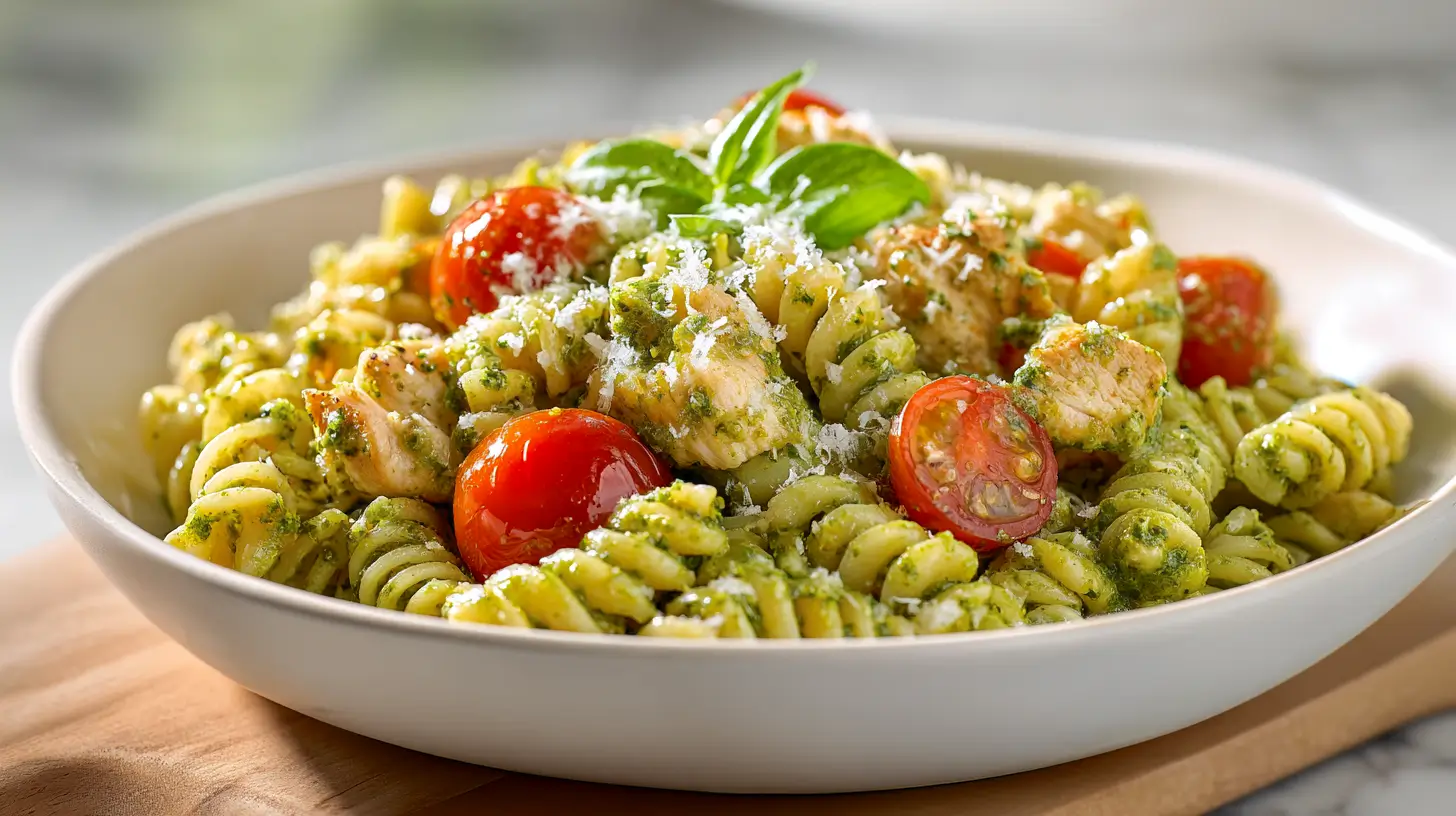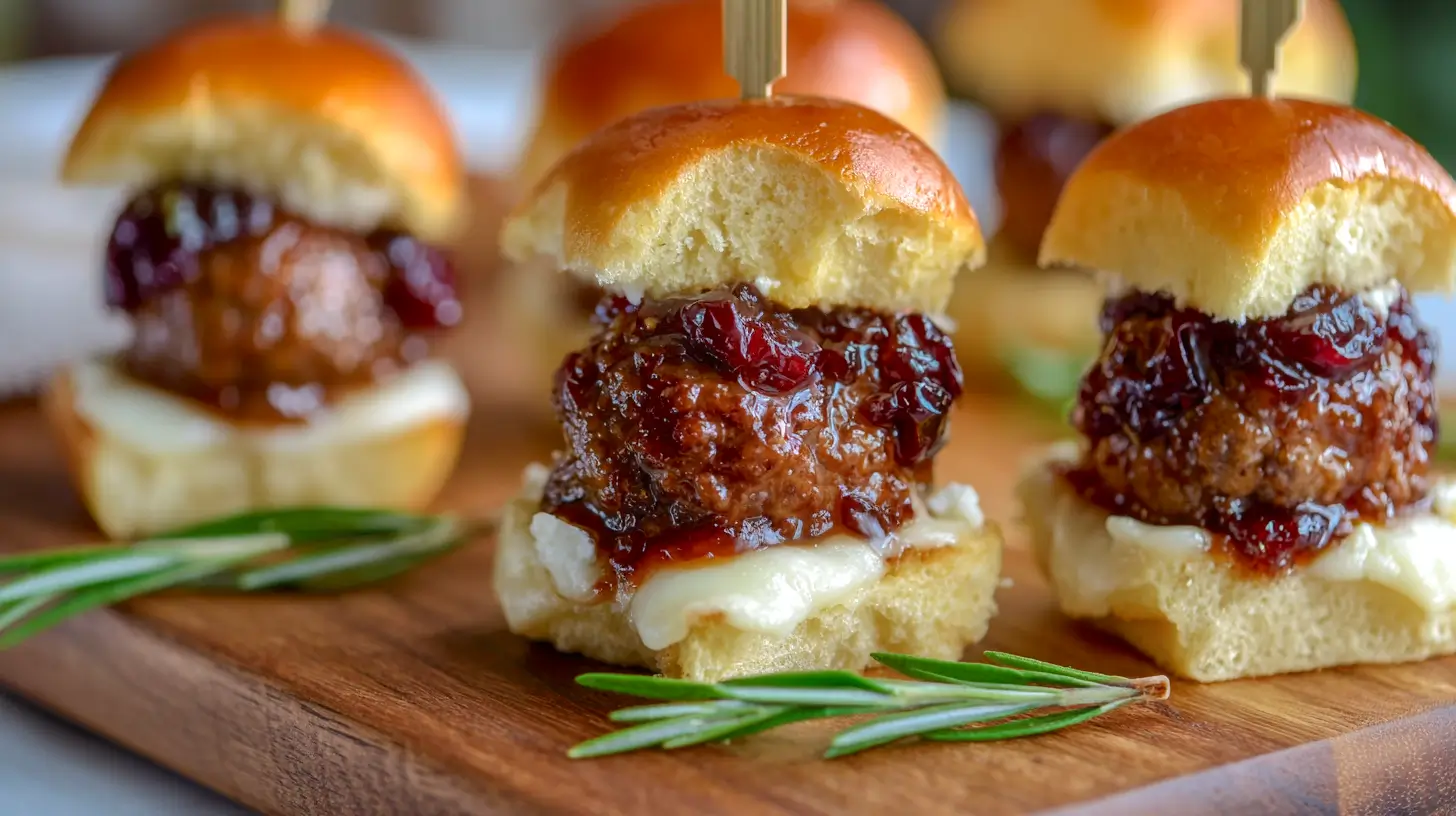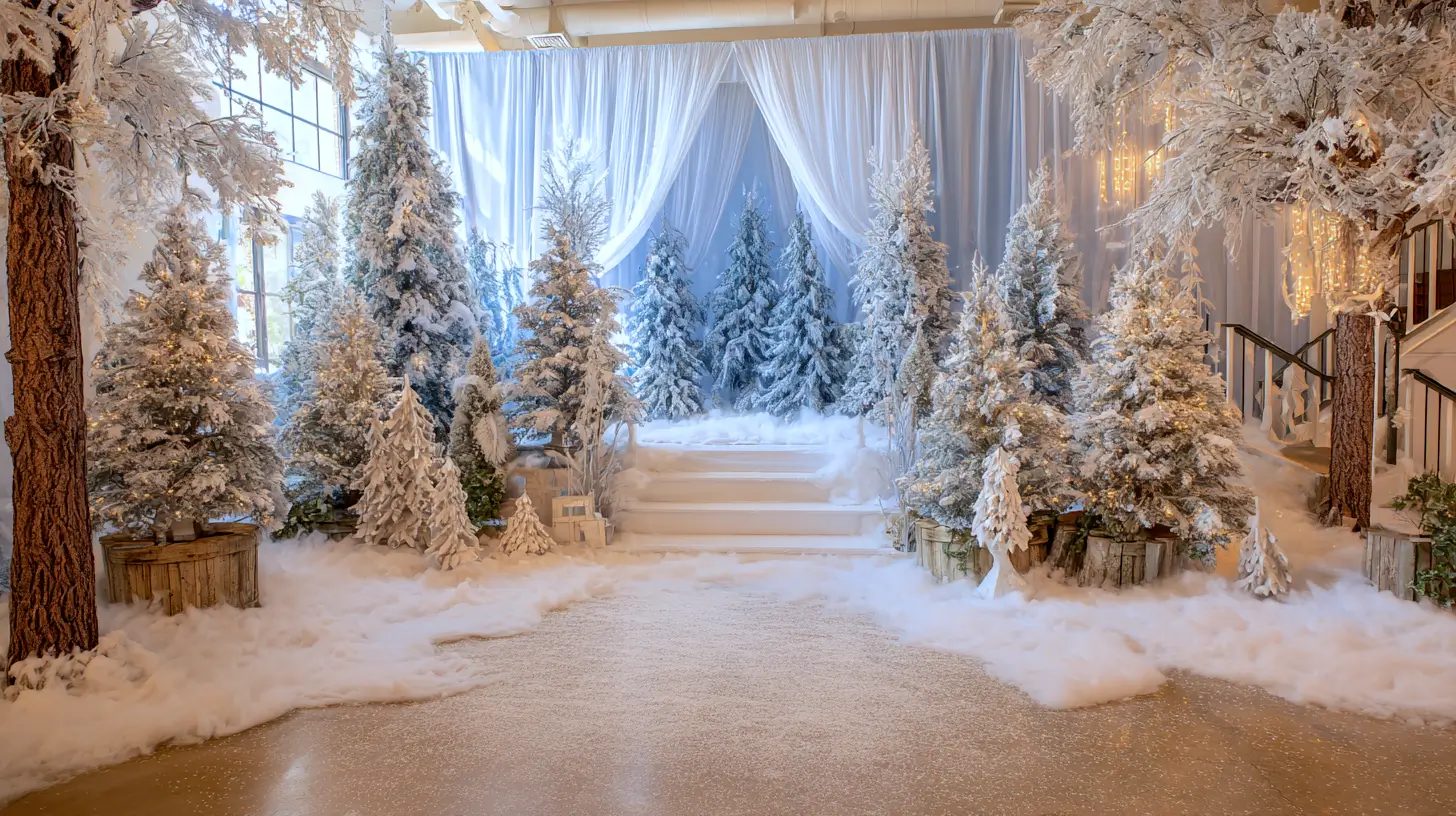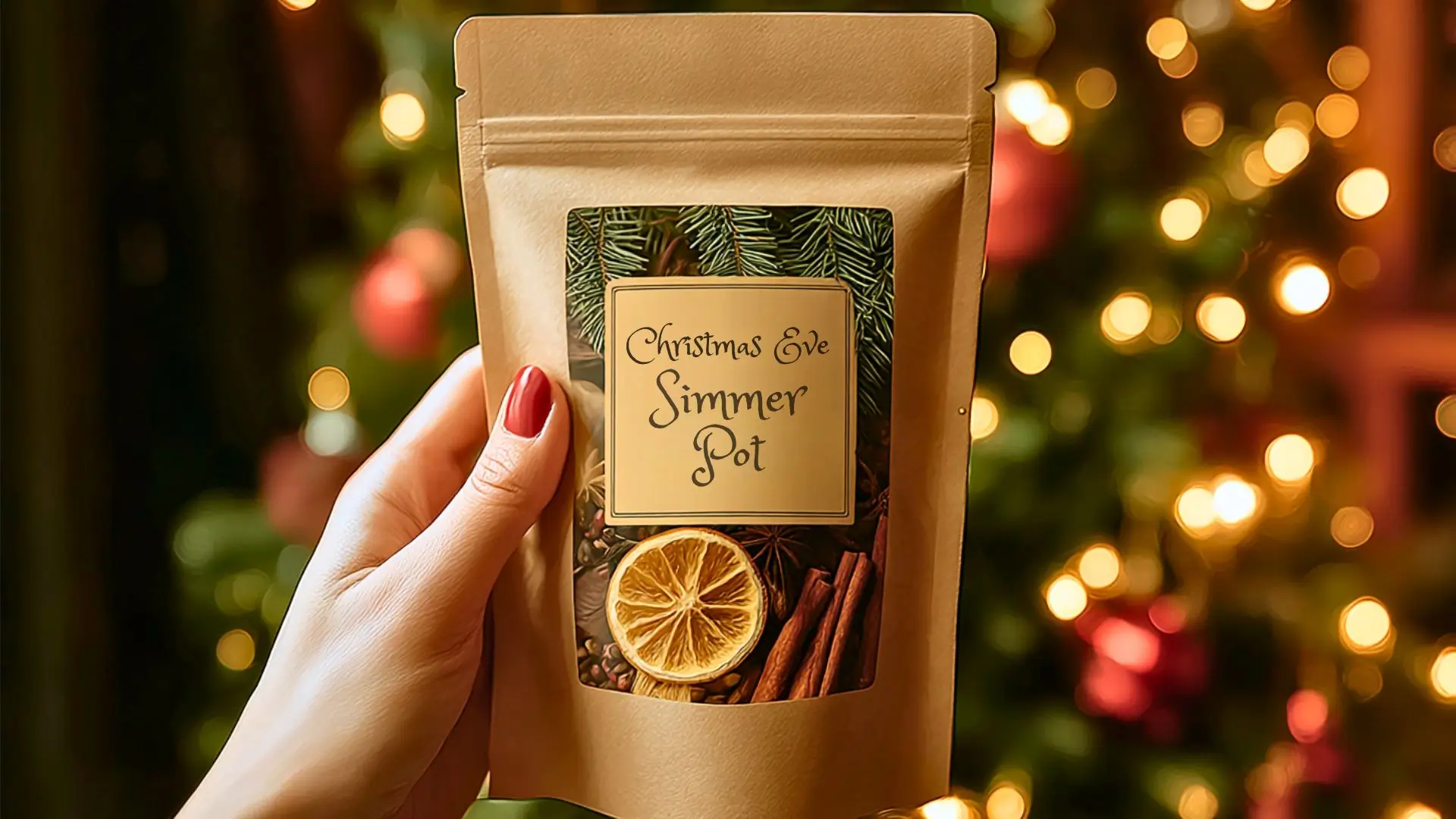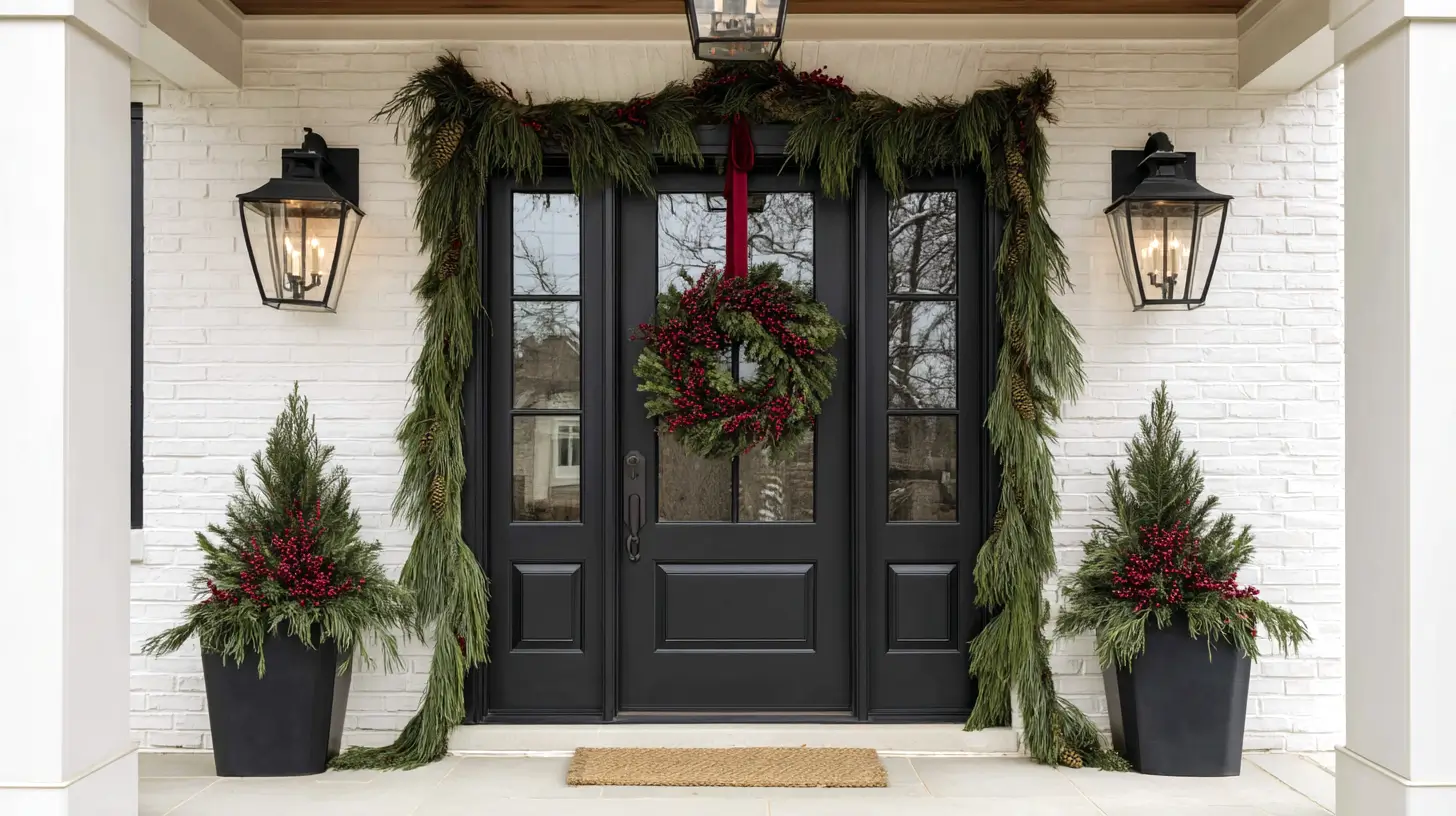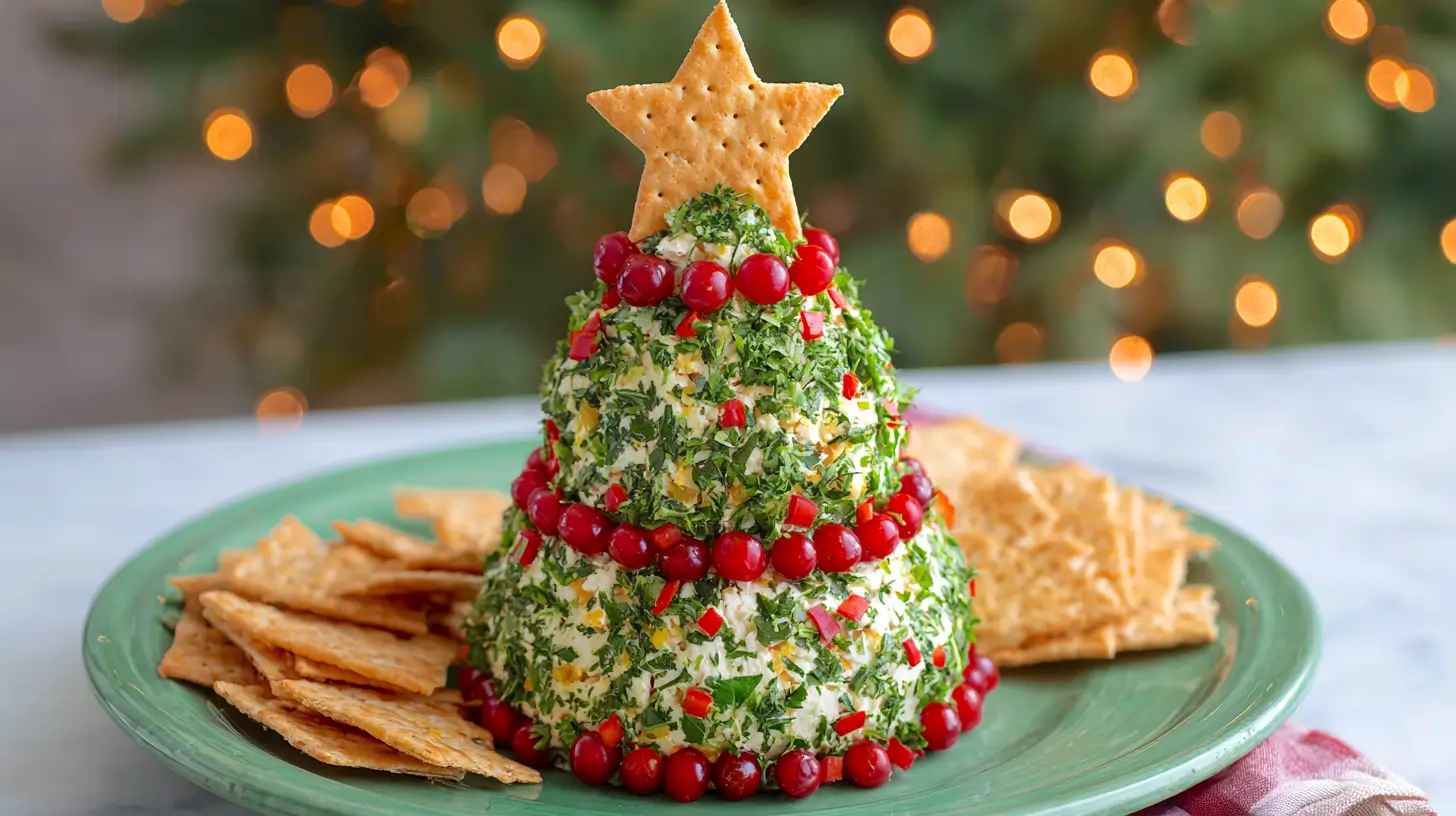I’m going to say it right away: a winter wedding bouquet has a personality all its own. Instead of copying spring’s peonies or summer’s wildflowers, winter flowers stand out on their own. They’re bolder. They feel moodier. Costs often run lower too, if you know what you’re doing. That’s why I’m excited about this topic. There are so many affordable flowers and greenery choices for cold-weather weddings, and I want to break them down in a way that feels clear and doable. No one should feel like their bouquet has to cost as much as the dress.
I’ve noticed winter flowers come with a little more drama. Think rich reds, creamy whites, and deep greens that pop against snow or even just a cloudy backdrop. And don’t forget texture. Pine, berries, branches, even dusty eucalyptus all bring that seasonal vibe without needing a florist to work overtime. The cool part is you don’t have to overspend to get it. Some of the best stems are the ones that don’t scream “bridal” but still look chic in a bunch.
Here’s what I’ve found: when people picture a wedding bouquet, they usually imagine roses, peonies, or hydrangeas. Pretty, sure, but expensive. Winter gives you permission to play with blooms like ranunculus, amaryllis, and even carnations. Yes, carnations—when styled right—look lush and cost way less. Mix them with greenery or berries, and suddenly you have something straight out of a wedding magazine, minus the magazine price tag.
After being married for 25 years, I’ve seen how wedding details change, but flowers always stay unforgettable. So, in this post, I’m pulling together ideas for flowers, greenery, and fillers that really shine in colder months. We’ll talk about what makes them work, how to keep costs down, and why little details like texture matter so much. Think of it as your shortcut to building a bouquet that looks elegant, feels seasonal, and doesn’t break the bank.
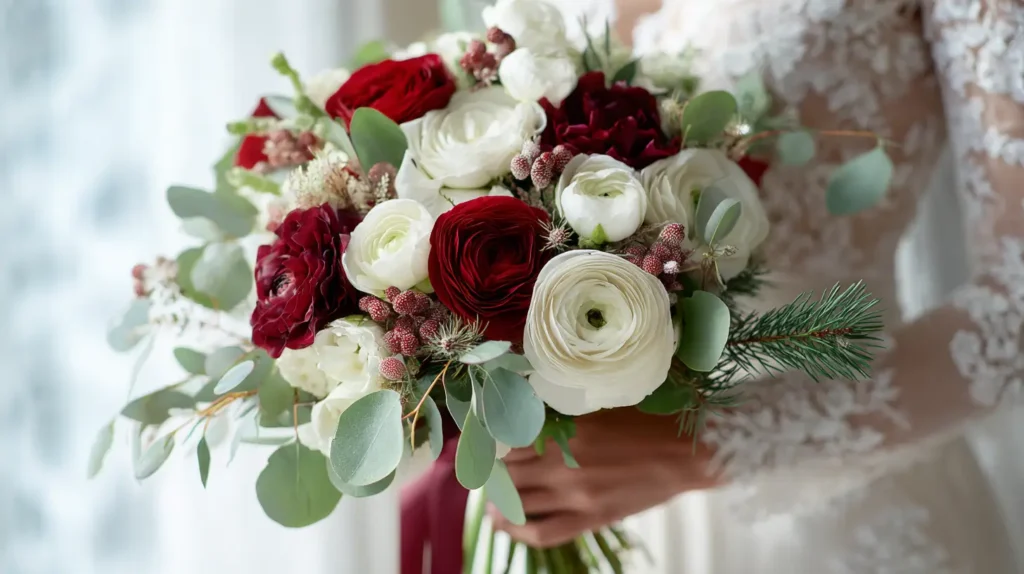
Some of the links on this site are affiliate links, which just means I may earn a small commission (at no extra cost to you) if you make a purchase. You can check out my full disclosure for all the details.
Why Winter Flowers Work So Well
Winter flowers carry weight. They’re sturdy, layered, and perfect for holding up in cold weather. That’s already a money-saver because you won’t need extras for replacements. Roses are still available, but they aren’t always cheap. Instead, you can lean into blooms like ranunculus, which feel like little rosettes but usually cost less than big garden roses. They look delicate but last surprisingly long.
Another solid choice is amaryllis. I know people usually think of them as houseplants around Christmas, but as cut flowers they make a bold statement. One stem can take up the visual space of three roses. That means fewer stems needed and fewer dollars spent. When paired with something simple, like evergreen sprigs, they look chic and intentional.
Carnations also shine this time of year. Hear me out—these are not the stiff grocery-store stems you might picture. Florists now offer ruffled, almost rose-like carnations in beautiful winter shades. Burgundy, cream, blush, and even soft gray tones. They fill in space, add volume, and save money. You can use them as the base of your winter wedding bouquet, then tuck in a few statement flowers to elevate the look.
Here’s another underrated player: chrysanthemums. They’re hearty, affordable, and available in lots of winter-ready colors. A deep bronze mum next to ivory roses and pine makes a bouquet look both luxurious and seasonal. The trick is mixing textures. If you only do smooth blooms, it can look flat. Add in something spiky, soft, or even dried, and suddenly the arrangement feels dimensional and polished.
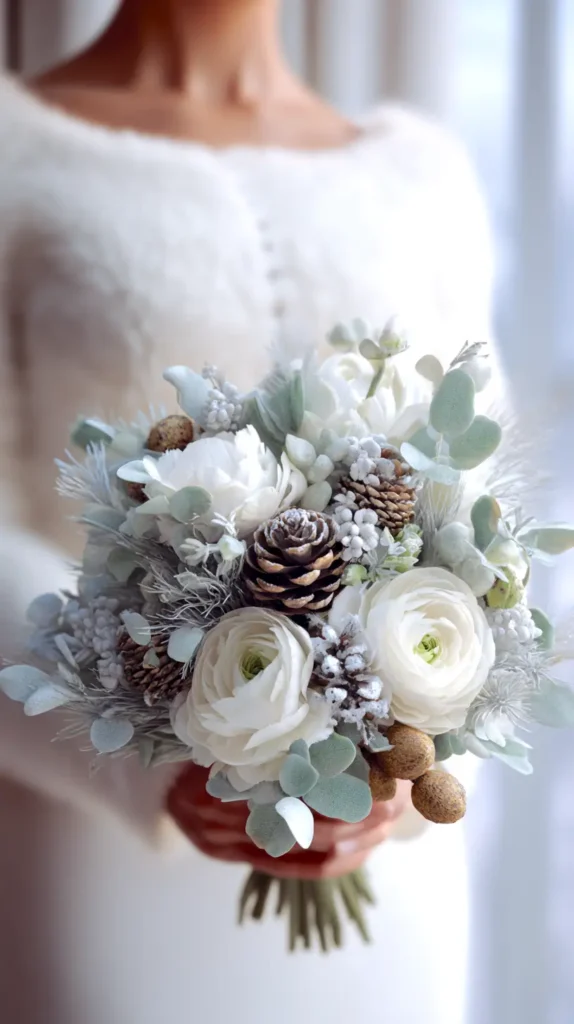
Greenery That Brings Winter Charm to Your Wedding Bouquet
Greenery is the backbone of a budget bouquet. In winter, it also adds that seasonal punch without costing much. Eucalyptus is always a crowd favorite. It’s affordable, smells lovely, and comes in varieties like seeded, silver dollar, and baby eucalyptus. Each adds a slightly different shape and tone. Seeded eucalyptus looks festive with little clusters that mimic berries. Silver dollar gives a wide, flat leaf that fills space quickly.
Evergreens are another great option. Pine, cedar, and fir are inexpensive and scream winter charm. Even a few sprigs can turn a simple bunch of flowers into a bouquet that feels seasonal. The bonus is that they last a long time without wilting. If you’re looking for that woodsy, romantic vibe, these greens are the way to go.
Dusty miller is another gem. Its soft, silvery leaves pair beautifully with white or deep red flowers. It has a velvety look that reads expensive even though it isn’t. Lamb’s ear can do the same thing, though sometimes it’s pricier depending on the source. Either way, that soft gray foliage adds contrast to bold winter blooms.
One greenery that people forget is ruscus. It’s a workhorse filler, with thin, glossy leaves that add movement and structure. Italian ruscus drapes in a way that feels elegant, while Israeli ruscus stands straighter for a cleaner look. Both are affordable and readily available year-round, making them ideal for keeping costs under control. Layer these greens behind just a handful of blooms, and your bouquet suddenly looks fuller, fancier, and more winter-appropriate.
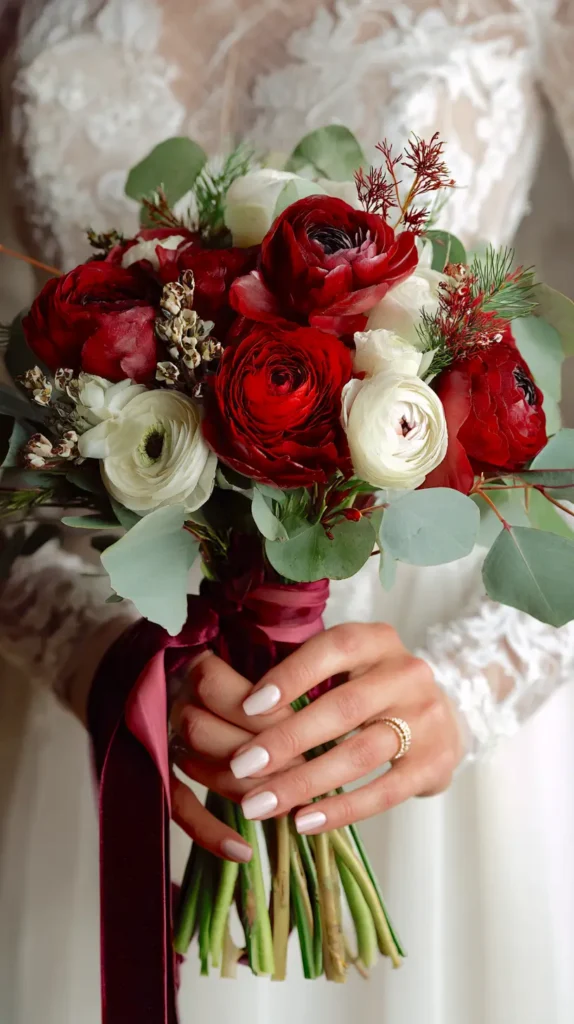
Adding Seasonal Texture And Fillers
What sets a winter bouquet apart is texture. It’s the pinecones, berries, and branches that give it that layered, seasonal feel. Hypericum berries are one of my favorites for winter bouquets. They come in shades like red, pink, or cream and add both color and texture. They’re small, but they catch the eye and make everything feel finished.
Another option is brunia berries. They’re silvery-gray and look almost frosted. Perfect for a winter theme without being too on-the-nose. Paired with white roses or ranunculus, they create a chic, understated contrast. If you’re going for more drama, pepperberries work well. They have a cascading effect and a dusty rose hue that fits right in with muted palettes.
Dried elements can also shine. Think dried thistle, pampas grass, or even branches sprayed white or gold. They add height and structure without adding much cost. Since they’re dried, they won’t wilt, which helps your bouquet hold up for photos. Pinecones tucked between flowers bring a rustic edge while staying budget-friendly.
Baby’s breath deserves a mention too. It’s affordable, lasts forever, and looks snowy when used in clusters. You can create a full winter wedding bouquet out of just baby’s breath and some greenery, and it will look modern instead of outdated. The trick is using it abundantly so it feels intentional. Add a ribbon wrap in velvet or satin, and it instantly looks luxe.
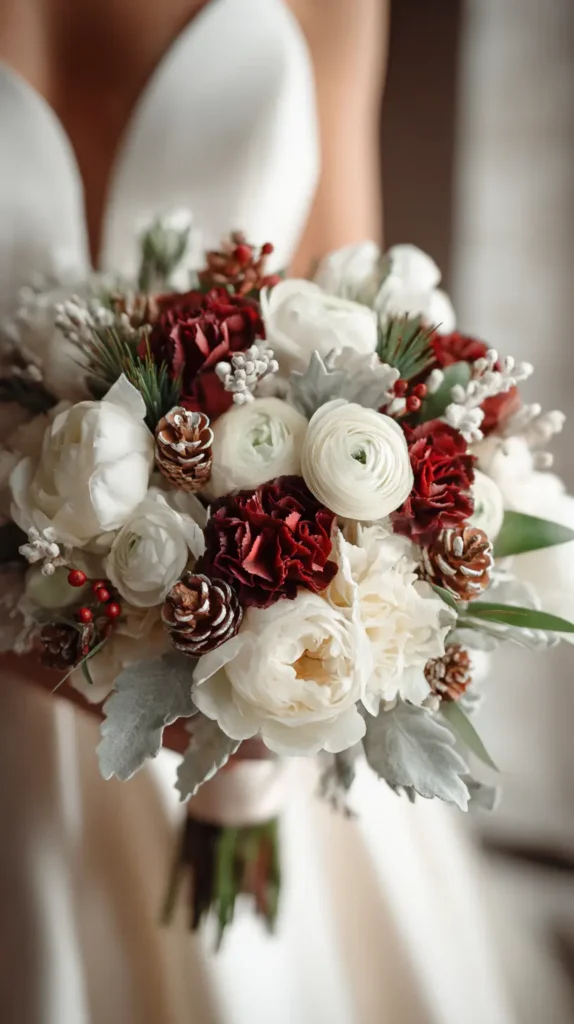
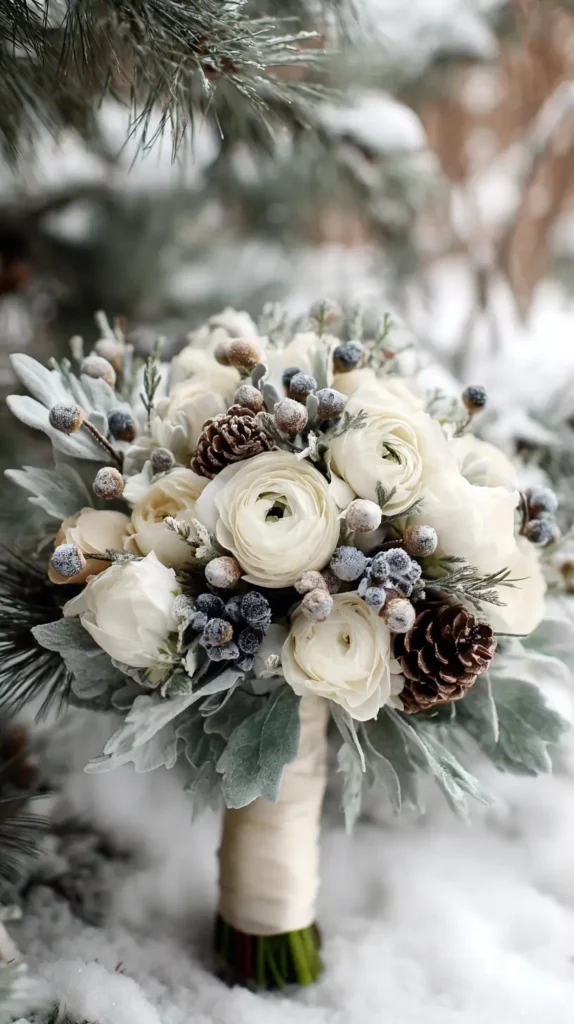
Playing With Color Palettes
Color changes everything about a bouquet. Winter gives you a chance to step outside typical pinks and pastels. Burgundy and deep red are obvious choices, but they never fail. Pair them with ivory blooms and evergreens, and you’ve got a classic holiday-inspired look. If you want softer, more romantic vibes, go with blush, cream, and silvery greenery. It feels airy but still grounded in the season.
One palette I’ve seen more brides lean into is jewel tones. Think emerald greens, sapphire blues, and ruby reds. These colors pop against white dresses and snowy backdrops. They also look great indoors, where lighting can sometimes flatten lighter shades. A few bold amaryllis in ruby red, accented with dark greenery, can anchor the whole arrangement.
For something more unexpected, icy tones work beautifully. White, pale blue, and silvery-gray flowers create a frosted look without feeling heavy. Add brunia berries, dusty miller, and white ranunculus, and you get a bouquet that looks elegant but still affordable. Accent with a ribbon in a deep navy or even velvet gray for contrast.
If you want budget-friendly impact, stick with two main colors and one accent. Too many shades can look chaotic. For example, white and burgundy with a touch of greenery keeps it cohesive. Blush and cream with silvery greens feels soft. You don’t need every color in the box—just enough to create balance and contrast.
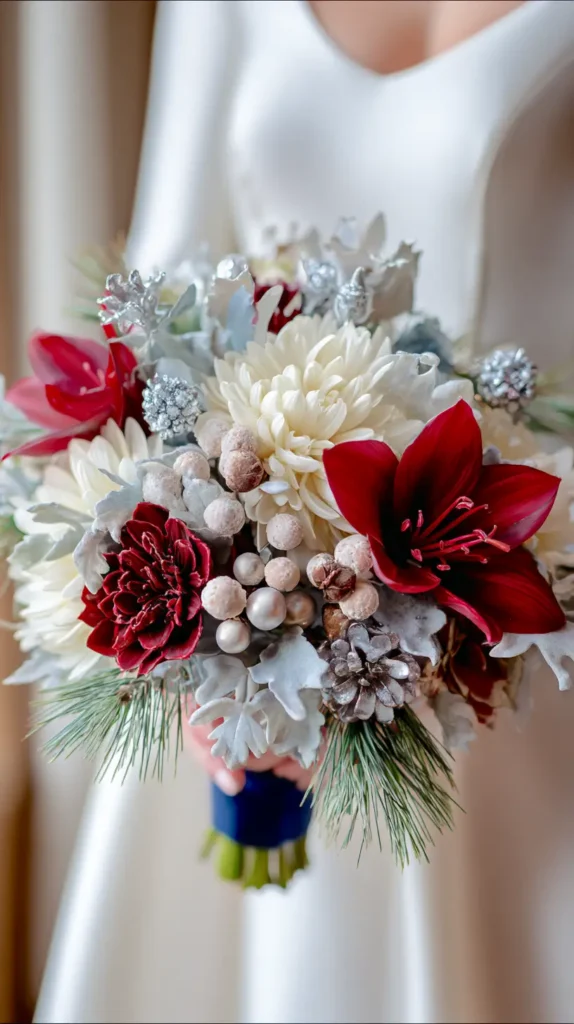
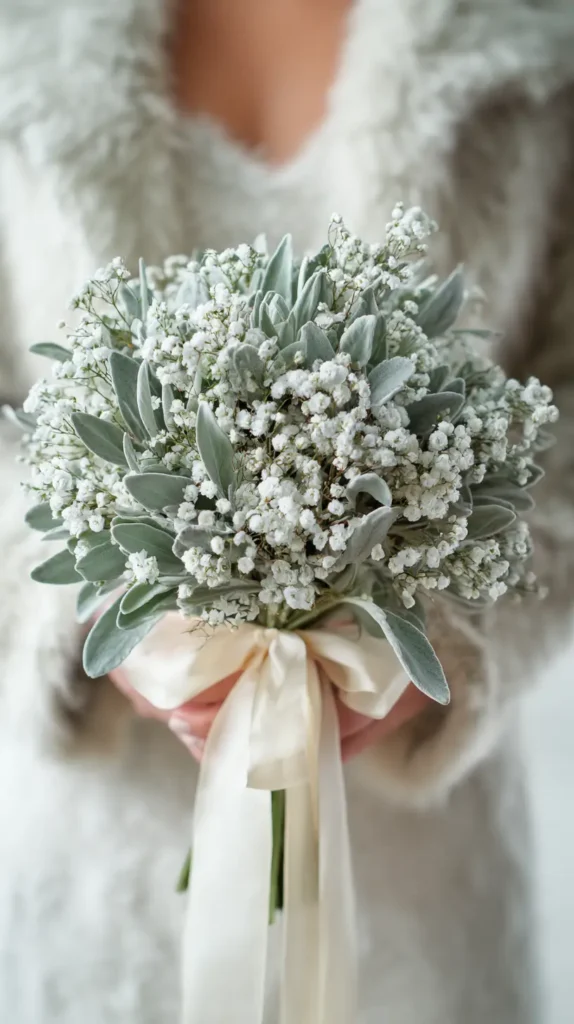
Budget-Friendly Flower Combinations
The easiest way to save money is mixing one or two focal flowers with affordable fillers. Here are some pairings that look chic without the high price tag:
- White roses with pine and baby’s breath
- Burgundy carnations with eucalyptus and hypericum berries
- Ranunculus with dusty miller and brunia berries
- Amaryllis with cedar sprigs and chrysanthemums
Each combination keeps the cost low by balancing pricier stems with cheaper fillers. The trick is proportion. Don’t overload your bouquet with statement flowers. Use just enough to catch the eye, then build around them. Florists often talk about the rule of thirds: one-third focal flowers, one-third fillers, and one-third greenery. That ratio helps keep everything balanced visually and financially.
One more tip: look for flowers in season. Even roses have better pricing when they’re plentiful. Ask your florist what’s most affordable in your area during winter. Sometimes imported flowers skyrocket in price, while local blooms cost less and last longer. Being flexible can save you big.
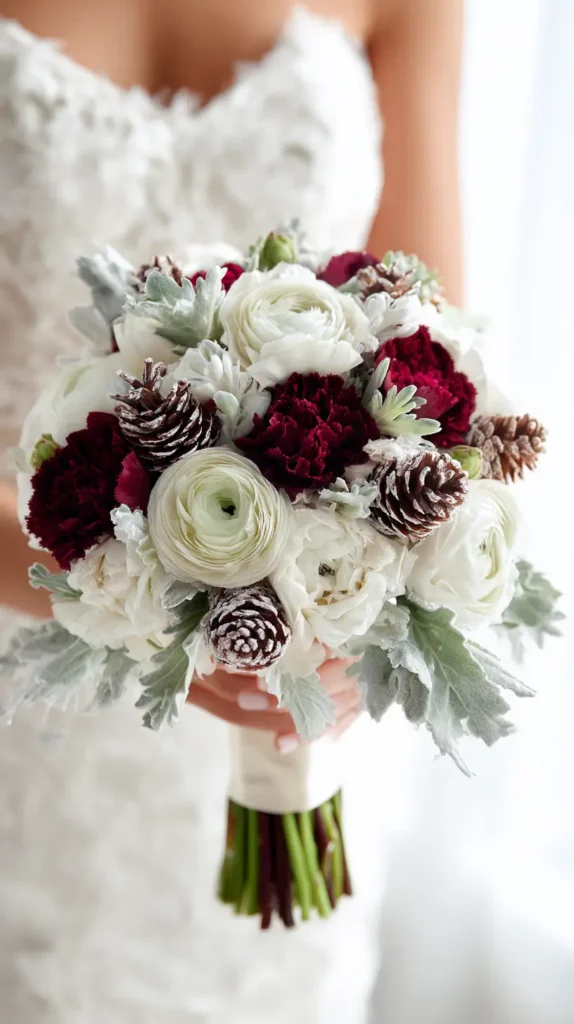
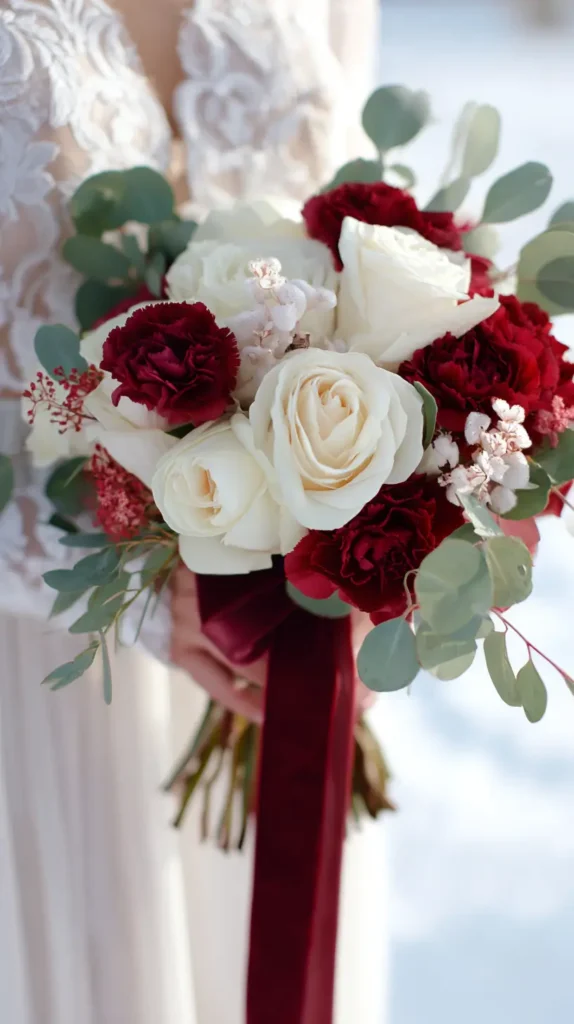
How To Make Your Winter Wedding Bouquet Look Luxe Without Spending Much
It’s not just about what flowers you use—it’s how you put them together. Wrapping the stems with a wide velvet ribbon instantly makes a bouquet look more expensive. Ribbon doesn’t cost much, but it adds a lot of polish. Another trick is layering textures. Smooth blooms, fluffy fillers, and spiky greens create depth. That kind of mix looks curated and professional.
Bouquet size also plays a role. Bigger isn’t always better. A medium-sized bouquet with carefully chosen blooms often looks more elegant than an oversized bunch of random flowers. Keep in mind, holding something heavy all day is tiring. A smaller bouquet feels chic and practical.
One thing I’ve noticed is that symmetry matters. Even if you’re going for a looser, organic look, balance the colors and textures. If you add a sprig of cedar on one side, tuck something of similar weight on the other. That kind of attention makes a bouquet look designer-made, even when it’s frugal.
Finally, don’t underestimate presentation. A bouquet photographed against your dress, with snow or greenery in the background, always looks elevated. Lighting and setting do a lot of heavy lifting. That’s why you don’t need the most expensive flowers to get stunning photos.
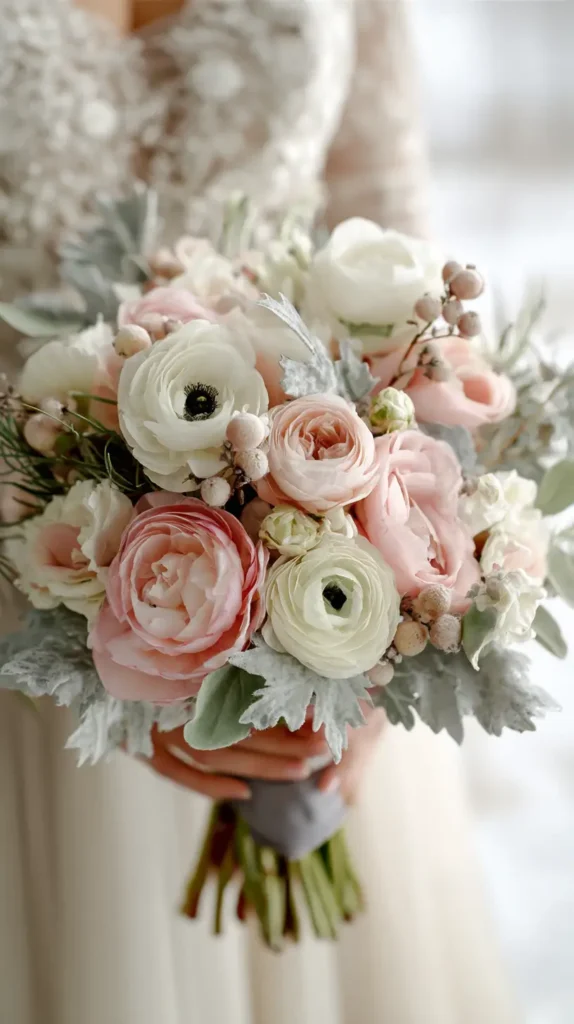
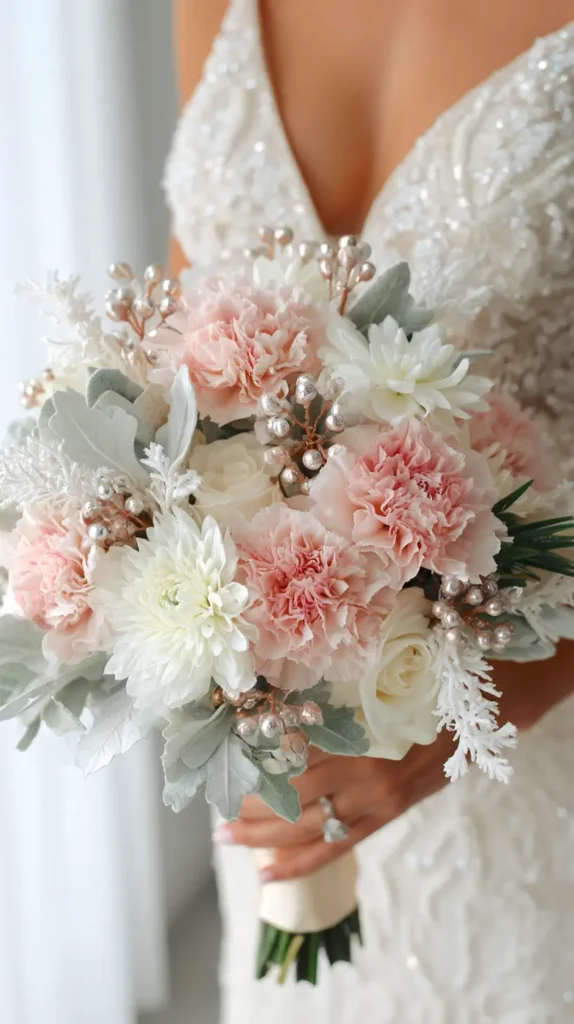
My Final Thoughts on Winter Wedding Bouquet Ideas
Living in Orlando, I’m surrounded by tropical plants year-round, so winter greens and berries feel extra magical to me.
There’s something about winter weddings that feels both cozy and elegant. I think a lot of it comes down to the flowers. A winter wedding bouquet doesn’t need to follow the same rules as spring or summer. It gets to play with texture, bold colors, and unexpected fillers. It can feel lush without being fussy, and chic without the price tag.
One thing I always notice is how greenery transforms the whole look. A simple mix of eucalyptus, pine, and a few blooms can suddenly feel romantic and seasonal. Add berries or even a ribbon, and you’ve got something that looks far more expensive than it is. That’s the fun of winter bouquets—they’re naturally dramatic and forgiving. You don’t have to overthink them.
I’ve found that people often assume “budget” means less beautiful. But honestly, some of the most striking arrangements come from thoughtful, frugal choices. A mix of carnations, brunia berries, and cedar can look just as chic as an armful of pricey roses. It’s about being intentional with texture, color, and proportion. That kind of creativity not only saves money but makes the bouquet feel unique.
If you’re planning your flowers, keep it simple. Start with one or two statement blooms, add affordable fillers, and finish with greenery. Play with textures, think about color balance, and trust that less really can be more. Your bouquet doesn’t need to cost hundreds to feel special. It just needs the right mix of blooms that fit the season and your style. And if you ever need inspiration, Pinterest is full of winter-ready arrangements that prove chic and frugal really do go hand in hand.

